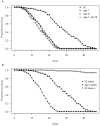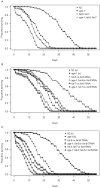DAF-16 and Δ9 desaturase genes promote cold tolerance in long-lived Caenorhabditis elegans age-1 mutants
- PMID: 21931751
- PMCID: PMC3169625
- DOI: 10.1371/journal.pone.0024550
DAF-16 and Δ9 desaturase genes promote cold tolerance in long-lived Caenorhabditis elegans age-1 mutants
Abstract
In Caenorhabditis elegans, mutants of the conserved insulin/IGF-1 signalling (IIS) pathway are long-lived and stress resistant due to the altered expression of DAF-16 target genes such as those involved in cellular defence and metabolism. The three Δ(9) desaturase genes, fat-5, fat-6 and fat-7, are included amongst these DAF-16 targets, and it is well established that Δ(9) desaturase enzymes play an important role in survival at low temperatures. However, no assessment of cold tolerance has previously been reported for IIS mutants. We demonstrate that long-lived age-1(hx546) mutants are remarkably resilient to low temperature stress relative to wild type worms, and that this is dependent upon daf-16. We also show that cold tolerance following direct transfer to low temperatures is increased in wild type worms during the facultative, daf-16 dependent, dauer stage. Although the cold tolerant phenotype of age-1(hx546) mutants is predominantly due to the Δ(9) desaturase genes, additional transcriptional targets of DAF-16 are also involved. Surprisingly, survival of wild type adults following a rapid temperature decline is not dependent upon functional daf-16, and cellular distributions of a DAF-16::GFP fusion protein indicate that DAF-16 is not activated during low temperature stress. This suggests that cold-induced physiological defences are not specifically regulated by the IIS pathway and DAF-16, but expression of DAF-16 target genes in IIS mutants and dauers is sufficient to promote cross tolerance to low temperatures in addition to other forms of stress.
Conflict of interest statement
Figures




Similar articles
-
Activated AKT/PKB signaling in C. elegans uncouples temporally distinct outputs of DAF-2/insulin-like signaling.BMC Dev Biol. 2006 Oct 4;6:45. doi: 10.1186/1471-213X-6-45. BMC Dev Biol. 2006. PMID: 17020605 Free PMC article.
-
ins-7 Gene expression is partially regulated by the DAF-16/IIS signaling pathway in Caenorhabditis elegans under celecoxib intervention.PLoS One. 2014 Jun 19;9(6):e100320. doi: 10.1371/journal.pone.0100320. eCollection 2014. PLoS One. 2014. PMID: 24945567 Free PMC article.
-
Shared transcriptional signature in Caenorhabditis elegans Dauer larvae and long-lived daf-2 mutants implicates detoxification system in longevity assurance.J Biol Chem. 2004 Oct 22;279(43):44533-43. doi: 10.1074/jbc.M406207200. Epub 2004 Aug 11. J Biol Chem. 2004. PMID: 15308663
-
DAF-16/FoxO in Caenorhabditis elegans and Its Role in Metabolic Remodeling.Cells. 2020 Jan 2;9(1):109. doi: 10.3390/cells9010109. Cells. 2020. PMID: 31906434 Free PMC article. Review.
-
Hormesis and aging in Caenorhabditis elegans.Exp Gerontol. 2006 Oct;41(10):935-9. doi: 10.1016/j.exger.2006.09.004. Epub 2006 Oct 24. Exp Gerontol. 2006. PMID: 17067771 Free PMC article. Review.
Cited by
-
Characterization of three Δ9-fatty acid desaturases with distinct substrate specificity from an oleaginous fungus Cunninghamella echinulata.Mol Biol Rep. 2013 Jul;40(7):4483-9. doi: 10.1007/s11033-013-2540-4. Epub 2013 May 5. Mol Biol Rep. 2013. PMID: 23645031
-
Transcriptome analyses of Ditylenchus destructor in responses to cold and desiccation stress.Genet Mol Biol. 2020 Mar 23;43(1):e20180057. doi: 10.1590/1678-4685-GMB-2018-0057. eCollection 2020. Genet Mol Biol. 2020. PMID: 32232317 Free PMC article.
-
Glucose induces sensitivity to oxygen deprivation and modulates insulin/IGF-1 signaling and lipid biosynthesis in Caenorhabditis elegans.Genetics. 2015 May;200(1):167-84. doi: 10.1534/genetics.115.174631. Epub 2015 Mar 10. Genetics. 2015. PMID: 25762526 Free PMC article.
-
Deep learning-enabled analysis reveals distinct neuronal phenotypes induced by aging and cold-shock.BMC Biol. 2020 Sep 23;18(1):130. doi: 10.1186/s12915-020-00861-w. BMC Biol. 2020. PMID: 32967665 Free PMC article.
-
Natural variations of cold tolerance and temperature acclimation in Caenorhabditis elegans.J Comp Physiol B. 2016 Dec;186(8):985-998. doi: 10.1007/s00360-016-1011-3. Epub 2016 Jun 18. J Comp Physiol B. 2016. PMID: 27318666 Free PMC article.
References
-
- Kenyon C. The genetics of ageing. Nature. 2010;464:504–512. - PubMed
-
- Friedman DB, Johnson TE. Three mutants that extend both mean and maximum life span of the nematode, Caenorhabditis elegans, define the age-1 gene. J Gerontol. 1988;43:102–109. - PubMed
-
- Kenyon C, Chang J, Gensch E, Rudner A, Tabtiang R. A C. elegans mutant that lives twice as long as wild type. Nature. 1993;366:461–464. - PubMed
-
- Lithgow GJ, White TM, Hinerfeld DA, Johnson TE. Thermotolerance of a long-lived mutant of Caenorhabditis elegans. J Gerontol. 1994;49:B270–B276. - PubMed
Publication types
MeSH terms
Substances
LinkOut - more resources
Full Text Sources
Research Materials
Miscellaneous

